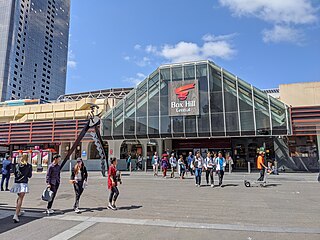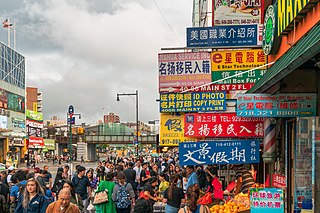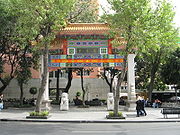
Chinatown is the catch-all name for an ethnic enclave of Chinese people located outside Greater China, most often in an urban setting. Areas known as "Chinatown" exist throughout the world, including Europe, Asia, Africa, Oceania, and the Americas.

Manhattan's Chinatown is a neighborhood in Lower Manhattan, New York City, bordering the Lower East Side to its east, Little Italy to its north, Civic Center to its south, and Tribeca to its west. With an estimated population of 90,000 to 100,000 people, Chinatown is home to the highest concentration of Chinese people in the Western Hemisphere. Manhattan's Chinatown is also one of the oldest Chinese ethnic enclaves. The Manhattan Chinatown is one of nine Chinatown neighborhoods in New York City, as well as one of twelve in the New York metropolitan area, which contains the largest ethnic Chinese population outside of Asia, comprising an estimated 893,697 uniracial individuals as of 2017.
Chinatowns in Latin America developed with the rise of Chinese immigration in the 19th century to various countries in Latin America as contract laborers in agricultural and fishing industries. Most came from Guangdong Province. Since the 1970s, the new arrivals have typically hailed from Hong Kong, Macau, and Taiwan. Latin American Chinatowns may include the descendants of original migrants — often of mixed Chinese and Latino parentage — and more recent immigrants from East Asia. Most Asian Latin Americans are of Cantonese and Hakka origin. Estimates widely vary on the number of Chinese descendants in Latin America but it is at least 1.4 million and likely much greater than this.

Urban Chinatowns exist in several major European cities. There is a Chinatown in London, England, as well as major Chinatowns in Manchester, Birmingham, Newcastle and Liverpool. In Paris there are two Chinatowns: one where many Vietnamese – specifically ethnic Chinese refugees from Vietnam – have settled in the Quartier chinois in the 13th arrondissement of Paris which is Europe's largest Chinatown, and the other in Belleville in the northeast of Paris. Berlin, Germany has two Chinatowns, one in the East and one in the West. Antwerp, Belgium also has an upstart Chinese community.
Chinese Cubans are Cubans of full or mixed Chinese ancestry who were born in or have immigrated to Cuba. They are part of the ethnic Chinese diaspora.

New York City is a large and ethnically diverse metropolis. It is the largest city in the United States with a long history of international immigration. The New York region continues to be by far the leading metropolitan gateway for legal immigrants admitted into the United States. The city is the geographical and demographic center of both the Northeast megalopolis and the New York metropolitan area, the largest metropolitan area in the U.S. by both population and urban area. With over 20.1 million people in its metropolitan statistical area and 23.5 million in its combined statistical area as of 2020, New York City is one of the world's most populous megacities.

An ethnoburb is a suburban residential and business area with a notable cluster of a particular ethnic minority population. Although the group may not constitute the majority within the region, it is a significant amount of the population. That can greatly influence the social geography within the area because of cultural and religious traditional values exhibited. Ethnoburbs allow for ethnic minority groups to maintain their individual identity, but that may also restrict their ability to fully assimilate into mainstream culture and society.

Little Fuzhou is a neighborhood in the Two Bridges and Lower East Side areas of the borough of Manhattan in New York City, United States. Little Fuzhou constitutes a portion of the greater Manhattan Chinatown, home to the highest concentration of Chinese people in the Western Hemisphere. Manhattan's Chinatown is also one of the oldest Chinese ethnic enclaves.

Since its founding in 1625 by Dutch traders as New Amsterdam, New York City has been a major destination for immigrants of many nationalities who have formed ethnic enclaves, neighborhoods dominated by one ethnicity. Freed African American slaves also moved to New York City in the Great Migration and the later Second Great Migration and formed ethnic enclaves. These neighborhoods are set apart from the main city by differences such as food, goods for sale, or even language. Ethnic enclaves provide inhabitants security in work and social opportunities, but limit economic opportunities, do not encourage the development of English speaking, and keep immigrants in their own culture.

The first Brooklyn Chinatown, was originally established in the Sunset Park area of the New York City borough of Brooklyn. It is one of the largest and fastest growing ethnic Chinese enclaves outside of Asia, as well as within New York City itself. Because this Chinatown is rapidly evolving into an enclave predominantly of Fuzhou immigrants from Fujian Province in China, it is now increasingly common to refer to it as the Little Fuzhou or Fuzhou Town of the Western Hemisphere; as well as the largest Fuzhou enclave of New York City.

La Mesa is a borough of the municipality of Tijuana in Baja California, Mexico.

Chinatowns are enclaves of Chinese people outside of China. The first Chinatown in the United States was San Francisco's Chinatown in 1848, and many other Chinatowns were established in the 19th century by the Chinese diaspora on the West Coast. By 1875, Chinatowns had emerged in eastern cities such as New York City, Boston, and Philadelphia. The Chinese Exclusion Act of 1882 barred Chinese immigration to the United States, but the Magnuson Act of 1943 repealed it, and the population of Chinatowns began to rise again. In the 2010s, the downturn in the U.S. economy caused many Chinese Americans to return to China.

The New York metropolitan area is home to the largest and most prominent ethnic Chinese population outside of Asia, hosting Chinese populations representing all 34 provincial-level administrative units of China. The Chinese American population of the New York City metropolitan area was an estimated 893,697 as of 2017, constituting the largest and most prominent metropolitan Asian national diaspora outside Asia. New York City itself contains by far the highest ethnic Chinese population of any individual city outside Asia, estimated at 628,763 as of 2017.
As of 2012, 21.4% of the population in San Francisco was of Chinese descent, and there were at least 150,000 Chinese American residents. The Chinese are the largest Asian American subgroup in San Francisco. San Francisco has the highest percentage of residents of Chinese descent of any major U.S. city, and the second largest Chinese American population, after New York City. The San Francisco Area is 7.9% Chinese American, with many residents in Oakland and Santa Clara County. San Francisco's Chinese community has ancestry mainly from Guangdong province, China and Hong Kong, although there is a sizable population of ethnic Chinese with ancestry from other parts of mainland China and Taiwan as well.

There are multiple Chinatowns in the borough of Queens in New York City. The original Queens Chinatown emerged in Flushing, initially as a satellite of the original Manhattan Chinatown, before evolving its own identity, surpassing in scale the original Manhattan Chinatown, and subsequently, in turn, spawning its own satellite Chinatowns in Elmhurst, Corona, and eastern Queens. As of 2023, illegal Chinese immigration to New York has accelerated, and its Flushing neighborhood has become the present-day global epicenter receiving Chinese immigration as well as the international control center directing such migration.
Fuzhounese Americans, also known as Hokchew Americans or Fuzhou Americans or imprecisely Fujianese, are Chinese American people of Fuzhou descent, in particular from the Changle district. Many Chinese restaurant workers in the United States are from Fuzhou. There are also a number of undocumented Fuzhounese immigrants in the United States who are smuggled in by groups such as snakeheads.

Chinese Latin American or Chino-Latino cuisine, associated with Asian Latin Americans of Chinese origin, combines elements of Chinese cuisine with other Latin American influences. It is found in Chinese communities and Chinatowns across Latin America, including Peru and Cuba. It has spread to the United States with the migration of Asian Latin Americans, particularly the migration of Chinese Cubans to New York City.
New York City is home to the second-largest Taiwanese American population, after the Los Angeles metropolitan area, California, enumerating an estimated 40,000 to 50,000 individuals as of 2020.























